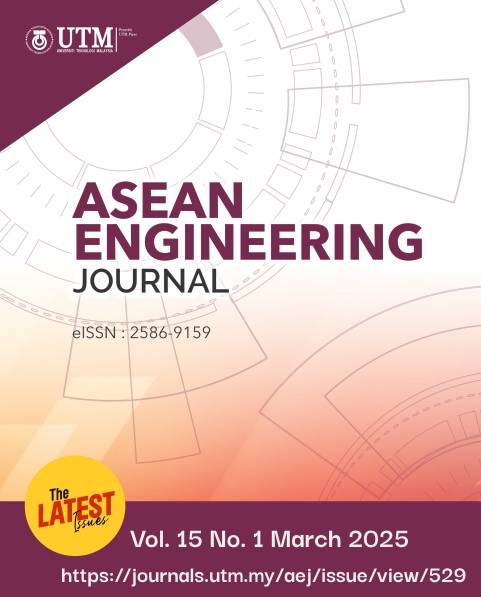SEISMIC SAFETY EVALUATION AND SVD BASED REMEDY RECOMMENDATION OF EXISTING R.C.C RESIDENTIAL BUILDINGS IN SOUTH INDIA
DOI:
https://doi.org/10.11113/aej.v15.22111Keywords:
Earthquake, Earthquake safety assessment, Rapid Visual Screening (RVS), linear and nonlinear analysis, equivalent static method, response spectrum method, time history analysis, Singular Valued Decomposition, Collaborative Filtering Recommendation, Retrofitting, Rehabilitation.Abstract
The project aims to enhance seismic safety in high-risk areas of Tamil Nadu, India, by conducting evaluations of 10 existing reinforced concrete buildings. The evaluation process starts with rapid visual screening, which is used to identify the buildings which require further evaluations. Buildings selected for further assessment are modelled in structural analysis software, ETABS to carry out seismic analysis using linear analysis methods such as equivalent static and response spectrum methods. The next step is to perform a non-linear time-history analysis to evaluate the behavior of buildings under low to moderate ground motions. Finally, deficiencies in the buildings are identified, and retrofitting techniques are suggested. A key innovation lies in the use of machine learning, specifically Singular Valued Decomposition (SVD) based Collaborative Filtering (CF) recommendation approach, to provide tailored retrofitting suggestions, enhancing the effectiveness of seismic safety interventions, which may include strengthening existing structural components, adding damping systems, or improving connections between different elements. The study results can guide similar buildings in the region, and retrofitting techniques can minimize property damage and save lives during future earthquakes. This project combines rapid visual screening, linear and non-linear analysis, machine learning and retrofitting suggestions to improve the seismic safety of buildings in high-risk areas in Tamil Nadu, India.
References
Bektas et al., 2022. Conventional RVS Methods for Seismic Risk Assessment for Estimating the Current Situation of Existing Buildings: A State-of-the-Art Review, Sustainability. 14(5): 2583. DOI: https://doi.org/10.3390/su14052583
Kumar et al., 2020. A Primer on Rapid Visual Screening (RVS) Consolidating Earthquake Safety Assessment Efforts in India, Technical Report. DOI: 10.13140/RG.2.2.35546.21442
Lakshmi Prabha, 2020. Seismic evaluation of existing RCC buildings, Method, DOI: 10.13140/RG.2.2.11820.49281
Harirchian et al., 2020. Earthquake Safety Assessment of Buildings Through Rapid Visual Screening, Buildings 10(3): 51, DOI: https://doi.org/10.3390/buildings10030051
Kamasani, et al., 2019. Seismic Analysis of High-Rise Buildings (G+30) by Using ETABS, International Journal of Technical Innovation in Modern Engineering and Science, 5(3): 14600-14614, https://www.ijirset.com/upload/2017/july/287_ANALYSIS_RK.pdf
Naik, et al., 2017. Performance evaluation of 9 storey RC building located in North Goa, Procedia Engineering 173: 1841 – 1846, DOI: https://doi.org/10.1016/j.proeng.2016.12.231
Arya A. S. et al., 2014. Rapid Visual Screening of RCC Buildings, Earthquake Spectra 26(3): 709-729. DOI: https://doi.org/10.1193/1.3456711
Gandhi et al., 2014. Literature Review on Rapid Visual Survey and Seismic Vulnerability, Journal of The Institution of Engineers (India) Series A 94(3):187-197, DOI: https://doi.org/10.1007/s40030-013-0048-5
Kai Hua et al, 2012. Study on High-rise Structure with Oblique Columns by ETABS, SAP2000, MIDAS/GEN and SATWE, Procedia Engineering 31: 474 – 480. DOI: https://doi:10.1016/j.proeng.2012.01.1054
Sinha et al., 2004. A National Policy for Seismic Vulnerability Assessment of Buildings and Procedure for Rapid Visual Screening of Buildings for Potential Seismic Vulnerability, In Report to Disaster Management Division; Ministry of Home Affairs, Government of India: New Delhi, India. https://www.civil.iitb.ac.in/~rsinha/Vulnerability_Assessment.pdf
Chaimahawan et al, 2007. Simple Seismic Evaluation Methodology for Gravity-Designed Reinforced Concrete Building, Research and Development Journal. 18(1): 32 42, https://www.thaiscience.info/Journals/Article/R%26DT/10897174.pdf
Murty C. V. R., 2005. IITK - Earthquake Tips - Learning Earthquake Design and Construction, IIT Kanpur, In report to Ministry of Urban Development & Poverty Alleviation, India
Rai D. C., 2005. Review of Documents on Seismic Evaluation of Existing Buildings, IIT Kanpur-GSDMA-EQ03-V1.0, https://www.iitk.ac.in/nicee/IITK-GSDMA/EQ03.pdf
Rai D. C., 2004. Seismic Evaluation and Strengthening of Existing Buildings, IIT Kanpur-GSDMA-EQ24-V2.0 https://www.iitk.ac.in/nicee/IITK-GSDMA/EQ06.pdf
FEMA Washington D.C., 2002. FEMA 154 - Rapid Visual Screening of Buildings for Potential Seismic Hazards: A Handbook, Prepared for Federal Emergency Management Agency, Washington, D.C.https://www.fema.gov/sites/default/files/2020 07/fema_earthquakes_rapid visual screening of buildings for potential seismic hazards-a-handbook-third-edition-fema-p-154.pdf
Ramalingeswara Rao B 2000. Historical Seismicity and deformation rates in the Indian Peninsular Shield, Journal of Seismology 4: 247–258
DOI: https://doi:10.1023/A:1009863312431
Chen, H., Sheng, S., Xu, C. Y., Li, Z., Zhang, W., Wang, S., & Guo, S. 2021. A spatiotemporal estimation method for hourly rainfall based on F-SVD in the recommender system, Environmental Modelling & Software. 144 (2): 1-11, DOI: https://doi.org/10.1016/j.envsoft.2021.105148
Abinaya, S., & Kumar, K. U. 2024. Enhancing Multicriteria-Based Recommendations by Alleviating Scalability and Sparsity Issues Using Collaborative Denoising Autoencoder. Computers, Materials & Continua. 78(2): DOI: https://doi.org/10.32604/cmc.2024.047167
Abinaya, S., & Ramya, R. 2024. Enhancement in Context-Aware Recommender Systems–A Systematic Review. In 2024 Second International Conference on Emerging Trends in Information Technology and Engineering (ICETITE) 1-13. IEEE. DOI: 10.1109/ic-ETITE58242.2024.10493725
Abinaya, S., Alphonse, A. S., Abirami, S., & Kavithadevi, M. K. 2023. Enhancing context-aware recommendation using trust-based contextual attentive autoencoder. Neural Processing Letters, 55(5): 6843-6864. DOI: https://doi.org/10.21203/rs.3.rs-1813771/v1
















